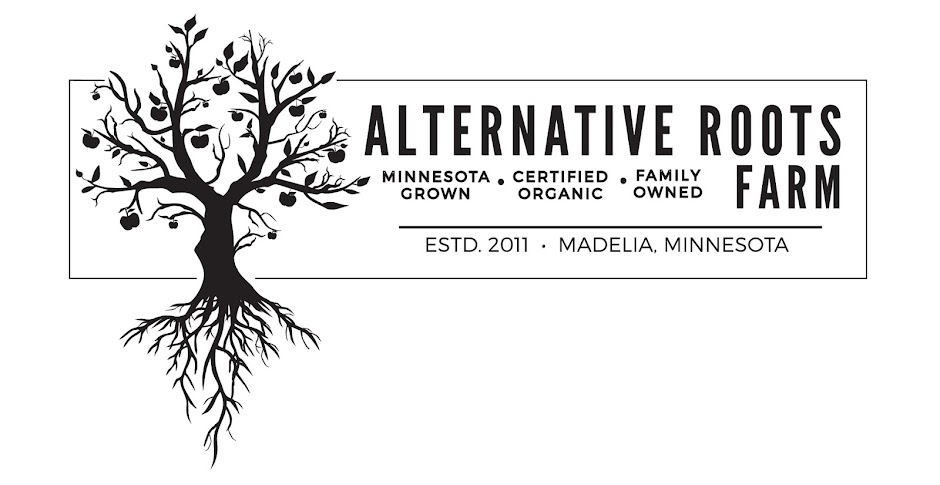 |
| March for Science - New Ulm |
Hello! Thank you for welcoming me here today and thank you for all being here supporting and celebrating science. As an organic farmer science is very important to me, so your presence and support is encouraging.
When thinking about what to talk with you about today, how science is important to what we do at our farm, many things came to mind. Than amazing world of mycorrhizal fungi around root systems. Food as medicine. How bitter flavors aide digestion comes to mind in the spring. The art of grafting apple trees. Pest cycles. Beneficial insects. Soil organisms. Riveting, yes?! Science helps me understand all of these systems, processes and interactions, so we can do our job well - so we can produce food and nurture our farm ecosystem.
While musing on all the ways science influences our jobs at the farm my mind kept coming back to all the ways science inspires us to do what we do and to keep doing it better.
Science drives my passion to farm nutritious, healthful and organic food for people, in harmony with our amazing ecosystem. So this became my path - to bring the environment, and natural health, into people's homes through food, and to deeply care for and nurture the bit of ecosystem that is our farm.
My husband and I farm, because we have a great respect for our natural environment and we wanted to practice natural resources conservation actively, on the ground. We choose to farm organically, because this is what science tells us creates healthy soils, healthy plants, clean water and clean air. And if the soil is not healthy - vibrant and full of organic matter, teaming with beneficial bacteria, fungi, nematodes - if it is not alive and well balanced how can the food be healthy? How can we be healthy?
A single teaspoon of rich soil can hold a billion bacteria, several yards of fungal filaments, several thousand protozoa and many, many nematodes.
Recently we purchased new land, which we are transitioning from conventional agriculture to organic apple orchard and pasture for our pigs. As we were planting trees a couple weeks ago we were astonished at how dead the soil seemed. As we dug our trees out of the nursery bed the soil was beautiful - loose and crumbly, dark, full of worms and organic matter. We planted these trees into our new field, where the soil was compacted, more chunky and cloddy than crumbly, devoid of much organic matter, devoid of worms. We are excited to bring this land back to life.
Back to that fungi I mentioned, each tree was planted with mycorrhizal fungi to nurture the health of the trees and the underground soil ecosystem. The endomycorrhizal fungi live partially inside and partially outside a plants root system. This symbiotic relationship fosters a greater exchange of nutrients. The fungi helps the plant take up more water and nutrients than the plant can do on its own; then the plant pays the fungi back in carbon. Nurturing this relationship is a long-term investment, that thrives with lack of disturbance, which is why we use minimal tillage and are moving to no-till.
This fascinates me. Science helps me understand.
Parasitic wasps lay eggs in or on host insects - pests like aphids and cabbage worms - as the eggs hatch the prey is consumed.
This fascinates me.
These natural processes and interactions are amazing and science - hard core research and hands on citizen science - helps us to better understand what we can do to nurture them to better create ecosystem services into all parts of our farm and farming.
Over the last several years we have worked in partnership with the University of Minnesota on carious research projects at our farm. Early detection monitoring for new and emerging pests and diseases. A trial of native Minnesotan mycorrhizal fungi. Monitoring a bee nesting block for the Bee Lab. This year we are building a passive solar greenhouse for growing in the winter, designed by the UMN. All this research is so import and and needed!
My passion for farming is driven, in part, by the fact that there is always so much to learn - there is always something to observe and explore. Science fuels this inspiration daily. Sometimes we forget to slow down and appreciate it, but there are so many examples around us, all the time.
The topic of science keeps bringing be mack to my passion, my inspiration, and that is really what I want to get down to. Find that bit of science, that nerdy fact, or process, or system, or machine that inspires you and let that help fuel you. Let science make your life more driven - at your job, or life at home, outside your job. It can foster appreciation, build creativity and give you new energy for the things you do day to day. Life is meant for learning and the possibilities are endless.
I am a farmer, the soil is my lab, where is yours?
• • •














